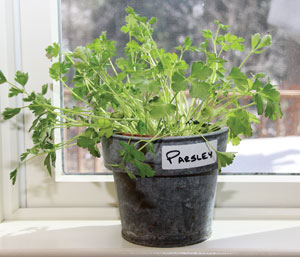Summer Essentials
 One of the many delights of the summer garden is fragrance, not just the heady floral scents particular to the season but those encountered in the herb garden. Plucking a leaf or two on a warm summer day cools the palm while a gentle rub releases volatile oils producing an aromatic vapor for a delightfully refreshing herbal scent.
One of the many delights of the summer garden is fragrance, not just the heady floral scents particular to the season but those encountered in the herb garden. Plucking a leaf or two on a warm summer day cools the palm while a gentle rub releases volatile oils producing an aromatic vapor for a delightfully refreshing herbal scent.
Herbal scents have long been appreciated through the ages and a history entwined with human civilization continues to provide medicinal, culinary, and aromatic needs. Examples of herbal use abound: Egyptian papyrus manuscripts depict herbs employed for cosmetics and embalming. The Romans introduced herbs across their empire, and medieval monks studied the use of herbs in physic gardens.
Many of the most common herbs hail from the Mediterranean region, which prefer a sunny site with well drained soil. A good herb starter kit would be parsley, chives, tarragon, and chervil, which comprise the classic French mix, fines herbes.
Parsley, the most versatile, comes either curled or flat leaved; the latter preferred by many as being more flavorful. Much used as a garnish that’s often pushed aside, it cleanses the breath, aids digestion, and is rich in vitamins A and C. Parsley is a biennial, but can be treated as an annual. It will take part shade and prefers a rich soil.
Chives provide a mild onion flavor while the round flower heads are both edible and decorative. After flowering, cut it back to one inch to encourage new growth but be aware that it does self-sow so you will have lots to share. Tarragon spreads via underground rhizomes and does not produce seed, so propagate by division or stem cuttings every two to three years. The mild anise flavored leaves are indispensable in many dishes and are a source of vitamins A and C. Chervil is the annual of the group and its flavor, when fresh, is incomparable. Throw your dried chervil out – it’s not worth the shelf space. Sown from seed its delicate ferny leaves are rich in vitamin C and ready for picking within six weeks. It merrily self-sows but hates to be moved, preferring light shade as full sun bleaches it out.
Another essential herb is thyme, Thymus vulgaris, a hardy, shrubby form and best for culinary use. Thymol, the oil extracted from the leaves, is a powerful antiseptic. It tends to sprawl so cut it back in the spring to keep it bushy and tidy.
Add some zing to your herbal palette with lemon balm. Long valued in perfumes and furniture polish it may be more familiar by its lemon-scented oil than taste, unless you sip liqueurs like Benedictine or Chartreuse. It does add a satisfying lemony twist to dishes and makes a great iced tea for a calming restorative with anti-viral properties. The attractive mound should be clipped regularly as the leaves have the best flavor before flowering.
What’s an herb garden without rosemary or sage? Rosemary won’t overwinter but grows well during the hot summer months. Sage, a woody sub-shrub with silvery- green or purple foliage plus variegated varieties is just outright handsome, and will look good almost anywhere.
Fresh herbs are unsurpassed for use in many culinary dishes and easy to grow, so plant several kinds, but if space is limited herbs do very nicely in pots. Many will provide a decorative element, so try a border of parsley or chives; and, as most herbs fraternize well with other plants, the possibilities are endless.
Summer is the time for the freshest picks from the garden. Planting herbs not only brings heavenly scent and decorative flourishes to the garden but delectable flavors to the table.
Ruth Furman is a Massachusetts Certified Horticulturist (MCH). She trained in horticulture in England and spent many happy years working and gardening there. To reach Ms. Furman, email her at: Ruth@wellesleywestonmagazine.com.
© 2011 Elm Bank Media | Beth Furman, Publisher | Beth@ElmBankMedia.com


recent comments